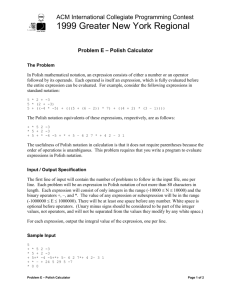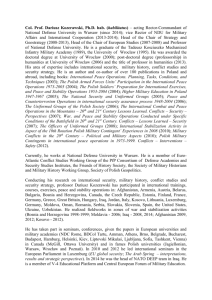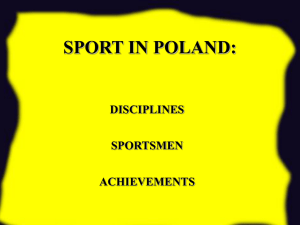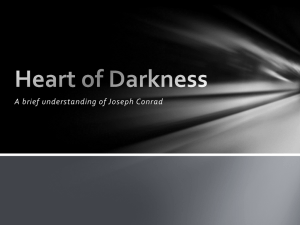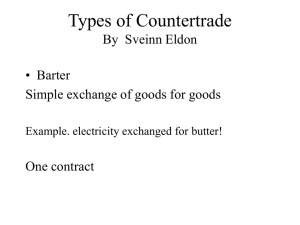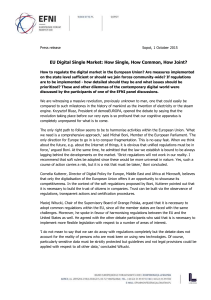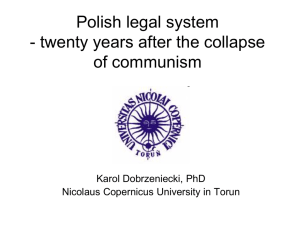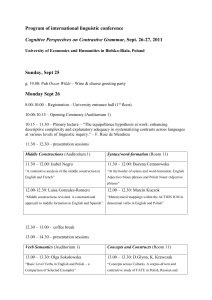Preparing a course programme for language teaching
advertisement
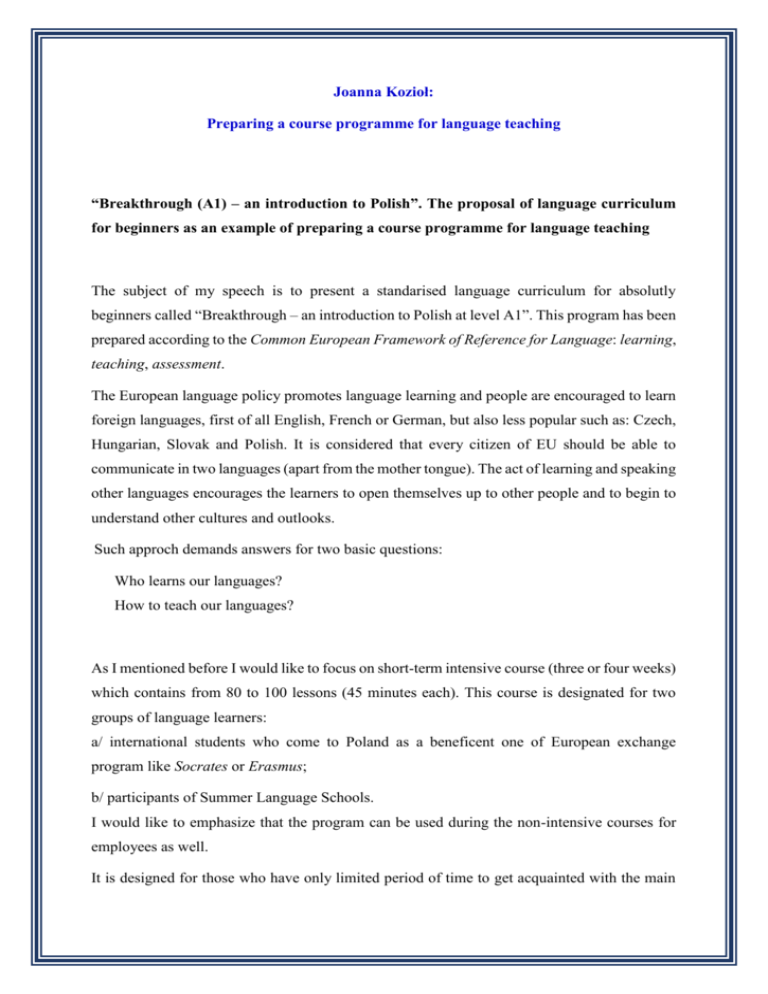
Joanna Kozioł: Preparing a course programme for language teaching “Breakthrough (A1) – an introduction to Polish”. The proposal of language curriculum for beginners as an example of preparing a course programme for language teaching The subject of my speech is to present a standarised language curriculum for absolutly beginners called “Breakthrough – an introduction to Polish at level A1”. This program has been prepared according to the Common European Framework of Reference for Language: learning, teaching, assessment. The European language policy promotes language learning and people are encouraged to learn foreign languages, first of all English, French or German, but also less popular such as: Czech, Hungarian, Slovak and Polish. It is considered that every citizen of EU should be able to communicate in two languages (apart from the mother tongue). The act of learning and speaking other languages encourages the learners to open themselves up to other people and to begin to understand other cultures and outlooks. Such approch demands answers for two basic questions: Who learns our languages? How to teach our languages? As I mentioned before I would like to focus on short-term intensive course (three or four weeks) which contains from 80 to 100 lessons (45 minutes each). This course is designated for two groups of language learners: a/ international students who come to Poland as a beneficent one of European exchange program like Socrates or Erasmus; b/ participants of Summer Language Schools. I would like to emphasize that the program can be used during the non-intensive courses for employees as well. It is designed for those who have only limited period of time to get acquainted with the main features of Polish language. The main intension is to support those three groups of learners and theirs teachers. In order to achieve our goal the didactic strategy should: Stress priority of spoken language and its role as the main device of communication over its written form. Pay attention to pronunciation. Prefer deduction instead of grammar induction. During the whole teaching process we: Combine listening, speaking, reading and writing in classroom activities, Bring learner’s fields of interest into the language training, Learn a language, instead of learning about it, Follow the language programme not a textbook. The teachers make the learning process more effective and easy if: Speak at normal rate, Use easy vocabulary and sentence structures, Repeat the same idea in different way to promote comprehension, Try to avoid use of “metalanguage” in order to translate or explain something. The language curriculum at Level A1 is called “Breakthrough – an introduction to Polish”. It consists of five unite parts: Reading with proper prononciation and intonation, Basic grammatical information, Basic vocabulary “me and my world”, Use of language in its communicative function in a set of simple situations, Comprehention of simple authentic texts. It is necessary to underline that all units are touhgt simultanies and can not be treated as a separate parts. Another but also very important aspects of teaching process are student’s textbooks. Since the last few years a lot of new and interesting books and other teaching materials can be found. The given program can be realized with following textbooks: “Hurra po polsku 1” - a student’s book and exercise book with CD by M. Małolepsza and A. Szymkiewicz, “Polski krok po kroku. Poziom A1” – a textbook, exercisebook by I. Stempek, A. Stelmach, S. Dawidek, A. Szymkiewicz. The last one proposal is also followed by suplementary materials accessible on line. This leads us directly to the last part of my talk - assesment process. The learners after such course should: speak about themselves and others: ask and answer questions about themselvs and others, meet people, talk about interest and hobbies and ask for somebody’s likes and dislikes, understand simple questions related to personal life, studies and work, everyday routines; understand: teacher’s instrutions, time and space relations, numbers and quantities, directions, understand and answer telephone calls; ask for: something in a shop, bill and methods of payment, information at bus/train station, services, the way to; can: buy tickets (bus/train or cinema), call a taxi, order in café and restaurant, invite others to a restaurant, cinem etc, offer meal or drinks to others, express requests in a simple way, agree with a suggestion or reject it; can write: a short informative message, postcards, greetings and wishes; fill simple forms; can: read aloud with proper pronounciation simple text, signs To sum up I’ll just say that the offered program is only the proposal how to organize the teaching process at beginner’s level. It gives some suggestions but leaves much space for freedom and flexibility in selecting the material and adopting it to the learners needs. Program of intesive Polish language course at: LEVEL A1 – “Breakthrough – an introduction to Polish” Reading a text aloud with a proper intonation. 1. Opanowanie umiejętności głośnego czytania tekstu z odpowiednią intonacją. 2. Basic grammatical information: Declination of nouns , adjectives, personal and possessive pronouns. Cardinal and ordinal numbers. Prepsition ( basic rules ). Conjugations in Polish language: present tense, past tense, future tenses, Aspect of verbs. Conditional mood of verbs: "chcieć and móc"(want – would like; can – could). Podstawowe informacje o strukturze języka: Deklinacja rzeczowników, przymiotników, zaimków osobowych i dzierżawczych. Liczebniki główne i porządkowe. Podstawowe zasady użycia przyimków. Koniugacje w języku polskim: czas teraźniejszy, czas przeszły, czas przyszły, Aspekt czasowników. Tryb przypuszczający czasowników: "chcieć i móc"(chciałbym, mógłbym). Basic vocabulary: "Me and my world": ( shops, restaurants and cafe-bars, foods, travelling, hobbies and intersts, post-office, banks, railway station, weather, city, people, directions, time and dates, ). Opanowanie podstawowego słownictwa; "Ja i mój świat." ( sklepy, restauracje i kawiarnie; jedzenie; zainteresowania; poczta; dworzec kolejowy; bank; pogoda; miasto; ludzie; kierunki; czas i daty; ). Use of language in its communicative function in a set of simple situations: Invitation ( responding for the invitation ). Asking for information. Expressing time ( past events, future plans, every day life, ). Expressing dates. Expressing spatial relations. Asking for the way and transportation. Simple telephone conversation. Making appointments. Polite expressing of requests. Asking for the advice and giving advice. Greetings and wishes. 4. Opanowanie umiejętności zachowania językowego w prostych, podstawowych sytuacjach komunikacyjnych: Zapraszanie i reakcja na zapraszanie. Pytanie o inforamcje. Wyrażanie czasu ( wydarzenia minione, plany na przyszłość, czynności dnia codziennego ). Wyrażanie daty. Wyrażanie relacji przestrzennych. Pytanie o drogę i środki komunikacji. Udział w prostej rozmowie telefonicznej. Umawianie się na spotkania. Wyrażanie prośby w sposób formalny i nieformalny. Pytanie i udzielanie rad. Składanie życzeń i pozdrowień. 5. Rozumienie prostych tekstów autentycznych. Approximative comprehention of simple authentic texts.
